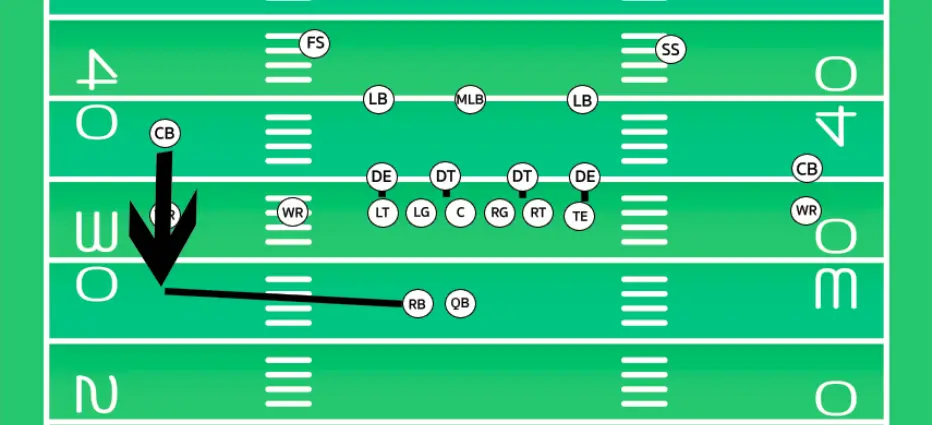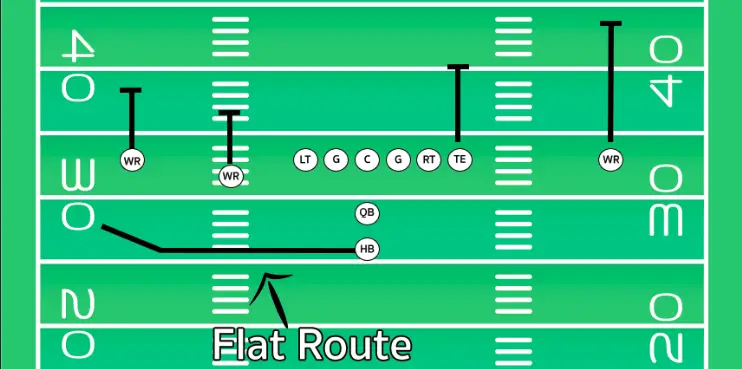When it comes to football terminology it can be tough to keep up with all the different lingo used to describe this game. This is why we’ve created this article explaining what a flat route is in football.
A flat route in football is a short route that has the route runner taking only a few steps down field before cutting towards the sideline.
The reason this route is named a flat route is that it directs the route runner towards the flat. The flat is any area of the field to the left or right of the formation within a few yards of the line of scrimmage.
In most cases, flat routes are going to be run by slot receivers, tight ends and running backs. This route is not run by outside receivers because of how close they line up to the sideline.
To run a flat route the player will start by taking a small number of steps downfield. The route runner will then turn ninety degrees towards the sideline.
A similar cut is made in many other routes in football including drag routes.
The cut towards the sideline should give the receiver separation for a short quick pass. This route is very similar to an out route the major difference being that it is a flat route is a much shallower route.
What To Know About Flat Routes
Now that you understand what a flat route is it’s time to learn a little more about this football route. Below are going to breakdown a few key things you should know about flat routes in football.
They Are Usually Check Downs
One thing you should know about flat routes is that they are rarely the intended target on a play.
Flat routes are short throws which means that unless the receiver gets some yards after the catch then this play is not gaining you many yards.
For this reason, this usually means that a flat route is a second or third read on a play. This is considered a check down because the quarterback will usually only throw to this route when others are covered.
Flat routes can be the intended receiver on short-yardage plays but you will find the majority of the time a flat route is passed to when there are no other options available.
Watch Out For The Big Hit
One downfall of flat routes is that on some occasions they can lead to big hits on the wide receiver. If a defender is playing a zone defense or using a cushion against the receiver then they will start the play several yards deeper down the field.
This means that when the ball is thrown to the player running the flat route the defender will be able to get a running start before making contact.

Additionally, a flat route pass is often going to be caught on the outside shoulder. This means the receiver will be turning outside to look back at the quarterback when catching the ball.
This leaves the receiver completely blind as to what is in front of him as he attempts to make the catch. And if it is a touch pass as opposed to a bullet pass it will give the defense plenty of time to react to the throw.
In most cases, the receiver will catch the ball and have to react to the incoming defender. But on some occasions, the receiver is unable to get his head around before the defender makes contact.
This results in a big blind side hit from a defender with a running start. To avoid these sorts of hits try and understand where the defender is before you look back to catch the ball.
Yardage Will Come From YAC
As we stated earlier in the article if you want to gain yards from a flat route you are going to need to get some yards after the catch. This route is usually only run a few yards down the field and there often several defenders waiting nearby.
In order to get the most out of a flat route the ball carrier must catch the ball and move downfield quickly. Oftentimes the yardage of the play will be determined by the ball carriers ability to beat a defender one on one.
Since this is an underneath pass the defender covering the receiver will still be between him and the endzone. Beating that first defender in the open field is the biggest factor in turning this play from a short gain to a big one.
That is all for flat routes, learn about slant routes and button hook patterns to understand more about route running in football.

